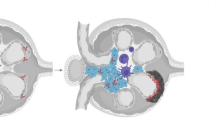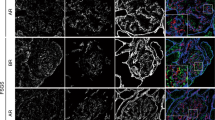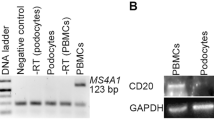Abstract
The damage and loss of podocytes is a primary hallmark of nephrotic syndrome. In the pursuit of targetable molecules that are involved in podocyte pathophysiology, some studies have identified B7-1 (also known as CD80) as a potential biomarker. Furthermore, B7-1 blockade has been proposed as a podocyte-specific treatment for patients with nephrotic syndrome who have limited therapeutic options, such as those with focal segmental glomerulosclerosis, minimal change disease, diabetic nephropathy and lupus nephritis. In this Perspectives article, we describe and compare supporting and contradicting data on the role of podocyte B7-1 in the pathogenesis of various podocytopathies. Moreover, we highlight crucial issues that should be addressed urgently — such as standardization of sample processing time, material conservation and antibody usage in immunohistochemical protocols — as a clinical trial that is investigating the efficacy of B7-1 blockade in treatment-resistant nephrotic syndrome is ongoing.
This is a preview of subscription content, access via your institution
Access options
Access Nature and 54 other Nature Portfolio journals
Get Nature+, our best-value online-access subscription
$29.99 / 30 days
cancel any time
Subscribe to this journal
Receive 12 print issues and online access
$209.00 per year
only $17.42 per issue
Buy this article
- Purchase on Springer Link
- Instant access to full article PDF
Prices may be subject to local taxes which are calculated during checkout

Similar content being viewed by others
References
Goldwich, A. et al. Podocytes are nonhematopoietic professional antigen-presenting cells. J. Am. Soc. Nephrol. 24, 906–916 (2013).
Reiser, J. et al. Induction of B7-1 in podocytes is associated with nephrotic syndrome. J. Clin. Invest. 113, 1390–1397 (2004).
Mundel, P. Podocytes and the quest for precision medicines for kidney diseases. Pflugers Arch. 469, 1029–1037 (2017).
US National Library of Medicine. ClinicalTrials.gov https://clinicaltrials.gov/ct2/show/NCT02592798 (2018).
Collins, M., Ling, V. & Carreno, B. M. The B7 family of immune-regulatory ligands. Genome Biol. 6, 223 (2005).
Sansom, D. M. CD28, CTLA-4 and their ligands: who does what and to whom? Immunology 101, 169–177 (2000).
Rau, F. C., Dieter, J., Luo, Z., Priest, S. O. & Baumgarth, N. B7-1/2 (CD80/CD86) direct signaling to B cells enhances IgG secretion. J. Immunol. 183, 7661–7671 (2009).
Alegre, M. L. & Fallarino, F. Mechanisms of CTLA-4-Ig in tolerance induction. Curr. Pharm. Des. 12, 149–160 (2006).
Mease, P. et al. Abatacept in the treatment of patients with psoriatic arthritis: results of a six-month, multicenter, randomized, double-blind, placebo-controlled, phase II trial. Arthritis Rheum. 63, 939–948 (2011).
Merrill, J. T. et al. The efficacy and safety of abatacept in patients with non-life-threatening manifestations of systemic lupus erythematosus: results of a twelve-month, multicenter, exploratory, phase IIb, randomized, double-blind, placebo-controlled trial. Arthritis Rheum. 62, 3077–3087 (2010).
Gardner, D., Jeffery, L. E. & Sansom, D. M. Understanding the CD28/CTLA-4 (CD152) pathway and its implications for costimulatory blockade. Am. J. Transplant. 14, 1985–1991 (2014).
Larsen, C. P., Knechtle, S. J., Adams, A., Pearson, T. & Kirk, A. D. A new look at blockade of T cell costimulation: a therapeutic strategy for long-term maintenance immunosuppression. Am. J. Transplant. 6, 876–883 (2006).
Larsen, C. P. et al. Rational development of LEA29Y (belatacept), a high-affinity variant of CTLA4-Ig with potent immunosuppressive properties. Am. J. Transplant. 5, 443–453 (2005).
Novelli, R., Gagliardini, E., Ruggiero, B., Benigni, A. & Remuzzi, G. Another piece of the puzzle of podocyte B7-1 expression: lupus nephritis. Nephron 133, 129–138 (2016).
Delville, M. et al. B7-1 blockade does not improve post-transplant nephrotic syndrome caused by recurrent FSGS. J. Am. Soc. Nephrol. 27, 2520–2527 (2016).
Baye, E. et al. The costimulatory receptor B7-1 is not induced in injured podocytes. Kidney Int. 90, 1037–1044 (2016).
Salant, D. J. Podocyte expression of B7-1/CD80: is it a reliable biomarker for the treatment of proteinuric kidney diseases with abatacept? J. Am. Soc. Nephrol. 27, 963–965 (2016).
Maas, R. J., Deegens, J. K., Smeets, B., Moeller, M. J. & Wetzels, J. F. Minimal change disease and idiopathic FSGS: manifestations of the same disease. Nat. Rev. Nephrol. 12, 768–776 (2016).
Garin, E. H. et al. Urinary CD80 excretion increases in idiopathic minimal-change disease. J. Am. Soc. Nephrol. 20, 260–266 (2009).
Garin, E. H. et al. Urinary CD80 is elevated in minimal change disease but not in focal segmental glomerulosclerosis. Kidney Int. 78, 296–302 (2010).
Ishimoto, T. et al. Toll-like receptor 3 ligand, polyIC, induces proteinuria and glomerular CD80, and increases urinary CD80 in mice. Nephrol. Dial. Transplant. 28, 1439–1446 (2013).
Ling, C. et al. Urinary CD80 levels as a diagnostic biomarker of minimal change disease. Pediatr. Nephrol. 30, 309–316 (2015).
Yu, C. C. et al. Abatacept in B7-1-positive proteinuric kidney disease. N. Engl. J. Med. 369, 2416–2423 (2013).
Lennon, R., Randles, M. J. & Humphries, M. J. The importance of podocyte adhesion for a healthy glomerulus. Front. Endocrinol. (Lausanne) 5, 160 (2014).
He, F. F., Chen, S., Su, H., Meng, X. F. & Zhang, C. Actin-associated proteins in the pathogenesis of podocyte injury. Curr. Genomics 14, 477–484 (2013).
Benigni, A., Gagliardini, E. & Remuzzi, G. Abatacept in B7-1-positive proteinuric kidney disease. N. Engl. J. Med. 370, 1261–1263 (2014).
Larsen, C. P., Messias, N. C. & Walker, P. D. B7-1 immunostaining in proteinuric kidney disease. Am. J. Kidney Dis. 64, 1001–1003 (2014).
Appel, G. B. Therapy: new data do not support use of abatacept in diabetic nephropathy. Nat. Rev. Nephrol. 11, 692–694 (2015).
Laszik, Z., Dobi, S. & Vincenti, F. B7-1/CD80 is not a reliable immunophenotypical marker of focal segmental glomerulosclerosis, membranous nephropathy, and diabetic nephropathy [abstract]. J. Am. Soc. Nephrol. Abstract Suppl. 25, TH-OR074 (2014).
Novelli, R., Gagliardini, E., Ruggiero, B., Benigni, A. & Remuzzi, G. Any value of podocyte B7-1 as a biomarker in human MCD and FSGS? Am. J. Physiol. Renal Physiol. 310, F335–F341 (2016).
Lee, S. W. et al. Tubular B7-1 expression parallels proteinuria levels, but not clinical outcomes in adult minimal change disease patients. Sci. Rep. 7, 41859 (2017).
Alachkar, N., Carter-Monroe, N. & Reiser, J. Abatacept in B7-1-positive proteinuric kidney disease. N. Engl. J. Med. 370, 1263–1264 (2014).
Garin, E. H. et al. Case series: CTLA4-IgG1 therapy in minimal change disease and focal segmental glomerulosclerosis. Pediatr. Nephrol. 30, 469–477 (2015).
Grellier, J. et al. Belatacept in recurrent focal segmental glomerulosclerosis after kidney transplantation. Transpl. Int. 28, 1109–1110 (2015).
Reiser, J. & Alachkar, N. Proteinuria: abate or applaud abatacept in proteinuric kidney disease? Nat. Rev. Nephrol. 10, 128–130 (2014).
Ueda, H. et al. Association of the T cell regulatory gene CTLA4 with susceptibility to autoimmune disease. Nature 423, 506–511 (2003).
Fiorina, P. et al. Role of podocyte B7-1 in diabetic nephropathy. J. Am. Soc. Nephrol. 25, 1415–1429 (2014).
Perico, N. et al. Evidence that an angiotensin-converting enzyme inhibitor has a different effect on glomerular injury according to the different phase of the disease at which the treatment is started. J. Am. Soc. Nephrol. 5, 1139–1146 (1994).
Brenner, B. M. et al. Effects of losartan on renal and cardiovascular outcomes in patients with type 2 diabetes and nephropathy. N. Engl. J. Med. 345, 861–869 (2001).
Gagliardini, E. et al. B7-1 is not induced in podocytes of human and experimental diabetic nephropathy. J. Am. Soc. Nephrol. 27, 999–1005 (2016).
Tervaert, T. W. et al. Pathologic classification of diabetic nephropathy. J. Am. Soc. Nephrol. 21, 556–563 (2010).
Herrera, M. et al. Inhibition of T cell activation by the CTLA4-Fc abatacept is sufficient to ameliorate proteinuric kidney disease. Am. J. Physiol. Renal Physiol. 312, F748–F759 (2017).
Norlin, J., Nielsen Fink, L., Helding Kvist, P., Douglas Galsgaard, E. & Coppieters, K. Abatacept treatment does not preserve renal function in the streptozocin-induced model of diabetic nephropathy. PLoS ONE 11, e0152315 (2016).
Kinoshita, K. et al. Costimulation by B7-1 and B7-2 is required for autoimmune disease in MRL-Faslpr mice. J. Immunol. 164, 6046–6056 (2000).
Huang, L. et al. Reducing progression of experimental lupus nephritis via inhibition of the B7/CD28 signaling pathway. Mol. Med. Rep. 12, 4187–4195 (2015).
Furie, R. et al. Efficacy and safety of abatacept in lupus nephritis: a twelve-month, randomized, double-blind study. Arthritis Rheumatol. 66, 379–389 (2014).
ACCESS Trial Group. Treatment of lupus nephritis with abatacept: the abatacept and cyclophosphamide combination efficacy and safety study. Arthritis Rheumatol. 66, 3096–3104 (2014).
Mundel, P. Podocyte-targeted treatment for proteinuric kidney disease. Semin. Nephrol. 36, 459–462 (2016).
Mundel, P. & Greka, A. Developing therapeutic ‘arrows’ with the precision of William Tell: the time has come for targeted therapies in kidney disease. Curr. Opin. Nephrol. Hypertens. 24, 388–392 (2015).
Trachtman, H. et al. Randomized clinical trial design to assess abatacept in resistant nephrotic syndrome. Kidney Int. Rep. 3, 115–121 (2018).
Acknowledgements
The authors thank K. Mierke, IRCCS–Istituto di Ricerche Farmacologiche Mario Negri, Bergamo, Italy, for editing the manuscript before submission. R.N. is a recipient of a fellowship from ‘Fondazione Aiuti per la Ricerca sulle Malattie Rare (ARMR)’, Bergamo, Italy.
Author information
Authors and Affiliations
Contributions
R.N. and G.R. wrote the manuscript; A.B. and G.R. critically revised the paper. All authors reviewed and approved the final manuscript.
Corresponding author
Ethics declarations
Competing interests
The authors declare no competing financial interests.
Additional information
Publisher’s note
Springer Nature remains neutral with regard to jurisdictional claims in published maps and institutional affiliations.
Glossary
- CTLA4-immunoglobulin fusion protein
-
(CTLA4-Ig). A soluble protein chimaera that consists of the extracellular domain of CTLA4 fused to the crystallizable fragment (Fc) portion of human IgG1.
- Microbead-mediated crosslinking
-
A laboratory technique that uses uniform polymer particles to bind and isolate specific targets.
- MRL-Faslpr mice
-
Lupus-prone mice that develop a systemic autoimmune syndrome that shares many features with human systemic lupus erythematosus.
- Polyinosinic:polycytidylic acid
-
(polyIC). Toll-like receptor 3 (TLR3) ligand that has structural similarities with double-stranded DNA. polyIC is used for the induction of podocytopathy and proteinuria.
- Synaptopodin
-
Actin-associated protein that is expressed by renal podocytes.
Rights and permissions
About this article
Cite this article
Novelli, R., Benigni, A. & Remuzzi, G. The role of B7-1 in proteinuria of glomerular origin. Nat Rev Nephrol 14, 589–596 (2018). https://doi.org/10.1038/s41581-018-0037-z
Published:
Issue Date:
DOI: https://doi.org/10.1038/s41581-018-0037-z
This article is cited by
-
Exploring the significance of interleukin-33/ST2 axis in minimal change disease
Scientific Reports (2023)
-
Benefit of B7-1 staining and abatacept for treatment-resistant post-transplant focal segmental glomerulosclerosis in a predominantly pediatric cohort: time for a reappraisal
Pediatric Nephrology (2023)
-
B7-1 mediates podocyte injury and glomerulosclerosis through communication with Hsp90ab1-LRP5-β-catenin pathway
Cell Death & Differentiation (2022)
-
The role of the immune system in idiopathic nephrotic syndrome
Molecular and Cellular Pediatrics (2021)
-
Therapeutic trials in adult FSGS: lessons learned and the road forward
Nature Reviews Nephrology (2021)



